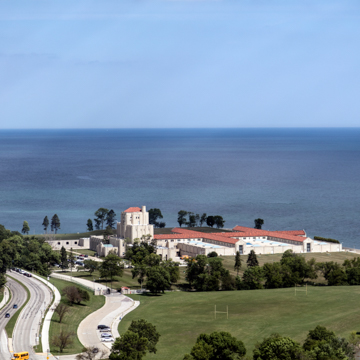The Works Progress Administration (WPA) erected many buildings in the Milwaukee area during the 1930s, but none is more outstanding than this huge water filtration plant. It is a benchmark in the history of Milwaukee civil engineering and a fine example of an architectural style that was often associated with the era of the Great Depression and WPA projects.
The Lannon stone building reveals its utilitarian but vital role of purifying Lake Michigan water for the city. Considerable attention was directed toward embellishing the exterior of the plant partly because of its highly visible location on public parkland along Milwaukee’s lakefront. The architectural focal point of the symmetrically planned building is a massive central clock tower accented with vertical piers. Construction of the plant came about when existing water purification facilities could barely keep up with demand. Here, water from Lake Michigan is purified in long, deep pools lined with special filtration materials. A recent overhaul of the facility improved chemical treatment and monitoring equipment.


